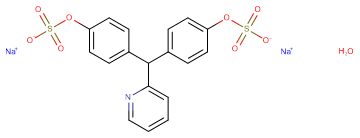
Sodium picosulfate monohydrate
CAS No. 1307301-38-7
Sodium picosulfate monohydrate( —— )
Catalog No. M11229 CAS No. 1307301-38-7
Sodium picosulfate monohydrate inhibits absorption of water and electrolytes, and increases their secretion.
Purity : >98% (HPLC)
 COA
COA
 Datasheet
Datasheet
 HNMR
HNMR
 HPLC
HPLC
 MSDS
MSDS
 Handing Instructions
Handing Instructions
| Size | Price / USD | Stock | Quantity |
| 25MG | 43 | In Stock |


|
| 50MG | 61 | In Stock |


|
| 100MG | 113 | In Stock |


|
| 200MG | 203 | In Stock |


|
| 500MG | Get Quote | In Stock |


|
| 1G | Get Quote | In Stock |


|
Biological Information
-
Product NameSodium picosulfate monohydrate
-
NoteResearch use only, not for human use.
-
Brief DescriptionSodium picosulfate monohydrate inhibits absorption of water and electrolytes, and increases their secretion.
-
DescriptionSodium picosulfate monohydrate inhibits absorption of water and electrolytes, and increases their secretion.
-
In Vitro——
-
In Vivo——
-
Synonyms——
-
PathwayOthers
-
TargetOther Targets
-
RecptorOthers
-
Research Area——
-
Indication——
Chemical Information
-
CAS Number1307301-38-7
-
Formula Weight499.42
-
Molecular FormulaC18H15NNa2O9S2
-
Purity>98% (HPLC)
-
SolubilitySoluble in Water
-
SMILESC1=CC=NC(=C1)C(C2=CC=C(C=C2)OS(=O)(=O)[O-])C3=CC=C(C=C3)OS(=O)(=O)[O-].O.[Na+].[Na+]
-
Chemical Name——
Shipping & Storage Information
-
Storage(-20℃)
-
ShippingWith Ice Pack
-
Stability≥ 2 years
Reference
molnova catalog



related products
-
Aristolochic Acid
Aristolochic acids are a family of carcinogenic, mutagenic, and nephrotoxic compounds commonly found in the Birthwort (Aristolochiaceae) family of plants.
-
Pep 4A
Pep 4A
-
proFIX28
proFIX28



 Cart
Cart
 sales@molnova.com
sales@molnova.com


